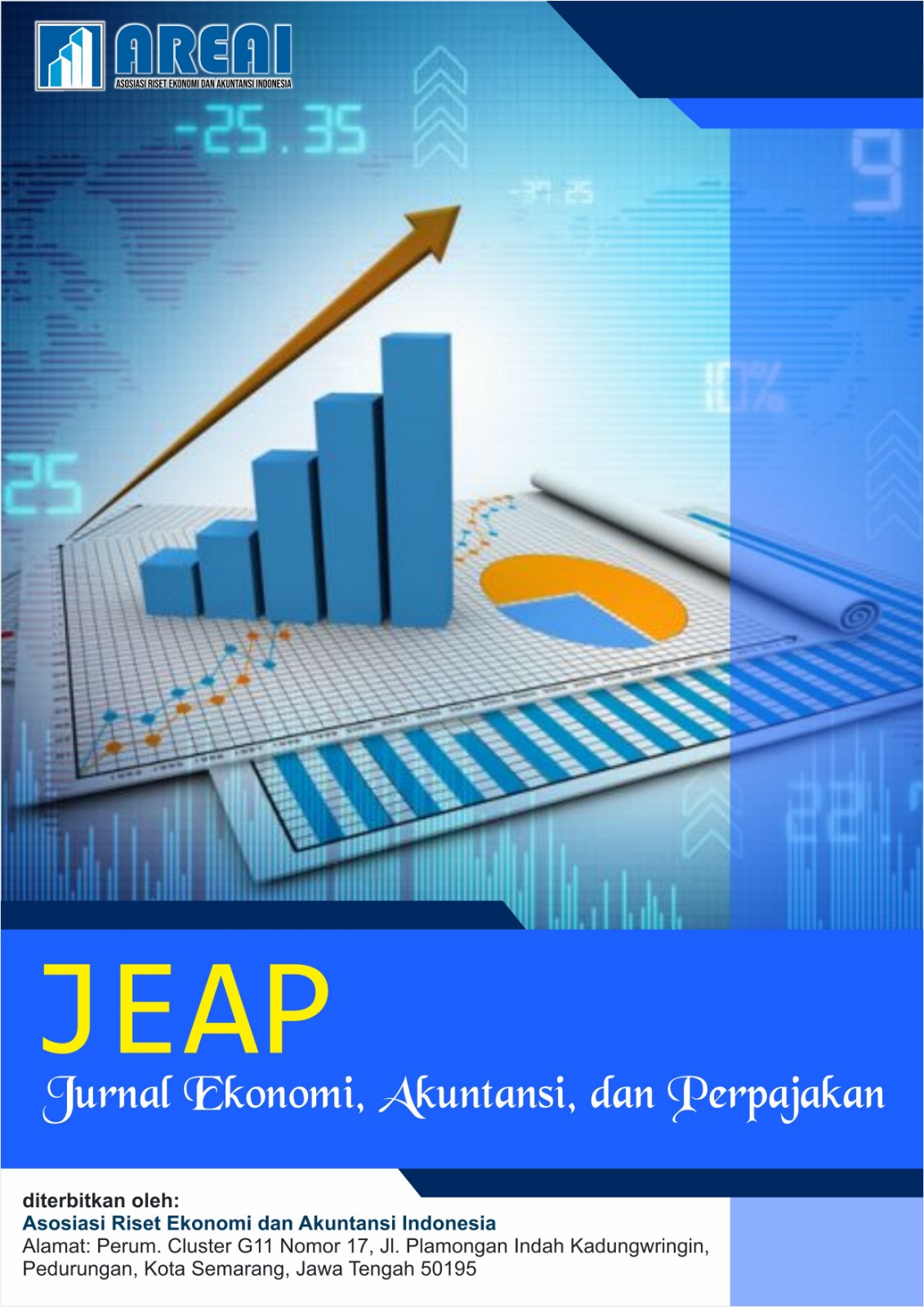Pengaruh Pengungkapan Environment, Social, and Governance (ESG) Terhadap Nilai Perusahaan dengan Keunggulan Kompetitif sebagai Variabel Moderasi
DOI:
https://doi.org/10.61132/jeap.v2i2.913Keywords:
competitive, advantage, ESG-disclosure, firm, valueAbstract
This study examines the effect of ESG disclosure on firm value and the moderating role of competitive advantage in energy sector companies listed on the Indonesia Stock Exchange during 2020–2023. Using a quantitative approach with purposive sampling and multiple linear regression analysis, the results show that ESG disclosure has a positive and significant effect on firm value. However, when competitive advantage is introduced as a moderating variable, the direct effect of ESG becomes insignificant, while the interaction between ESG disclosure and competitive advantage shows a positive and significant impact on firm value. These findings imply that ESG practices alone may not be sufficient to enhance firm value unless accompanied by a strong competitive position. The study highlights the importance of integrating ESG strategies with the company’s core competencies to maximize value creation, particularly in highly competitive industries like energy.
Downloads
References
Ananda, W., Pradesa, H. A., & Wijayanti, R. (2023). Pelaksanaan Sustainability Report Berdasarkan GRI Standards Guidelines Pada Perusahaan Manufaktur di Indonesia. 5(2).
Aydoğmuş, M., Gülay, G., & Ergun, K. (2022). Impact of ESG performance on firm value and profitability. Borsa Istanbul Review, 22, S119–S127. https://doi.org/10.1016/j.bir.2022.11.006
Chopra, S. S., Senadheera, S. S., Dissanayake, P. D., Withana, P. A., Chib, R., Rhee, J. H., & Ok, Y. S. (2024). Navigating the Challenges of Environmental, Social, and Governance (ESG) Reporting: The Path to Broader Sustainable Development. Sustainability, 16(2), 606. https://doi.org/10.3390/su16020606
Clarkson, M. B. E. (1995). A Stakeholder Framework for Analyzing and Evaluating Corporate Social Performance. The Academy of Management Review, 20, 92–117.
Clarkson, P. M., Li, Y., Richardson, G. D., & Vasvari, F. P. (2011). Does it really pay to be green? Determinants and consequences of proactive environmental strategies. Journal of Accounting and Public Policy, 30(2), 122–144. https://doi.org/10.1016/j.jaccpubpol.2010.09.013
Donaldson, T., & Preston, L. E. (1995). The Stakeholder Theory of the Corporation: Concepts, Evidence, and Implications. The Academy of Management Review, 20, 65–91.
Elkington, J. (1997). Cannibals with forks: The triple bottom line of 21st century business (Pbk. ed). Capstone.
Fatemi, A., Glaum, M., & Kaiser, S. (2018). ESG performance and firm value: The moderating role of disclosure. Global Finance Journal, 38, 45–64. https://doi.org/10.1016/j.gfj.2017.03.001
Freeman, R. E. (1984). Strategic management: A stakeholder approach. In Strategic Management: A Stakeholder Approach. https://doi.org/10.1017/CBO9781139192675
Grewatsch, S., & Kleindienst, I. (2017). When Does It Pay to be Good? Moderators and Mediators in the Corporate Sustainability–Corporate Financial Performance Relationship: A Critical Review. Journal of Business Ethics, 145(2), 383–416. https://doi.org/10.1007/s10551-015-2852-5
Harrison, J. S., & Wicks, A. C. (2013). Stakeholder Theory, Value, and Firm Performance. Business Ethics Quarterly, 23(1), 97–124. https://doi.org/10.5840/beq20132314
Hill, C. W. L., & Jones, T. M. (1992). STAKEHOLDER‐AGENCY THEORY. Journal of Management Studies, 29(2), 131–154. https://doi.org/10.1111/j.1467-6486.1992.tb00657.x
Hilson, G. (2012). Corporate Social Responsibility in the extractive industries: Experiences from developing countries. Resources Policy, 37(2), 131–137. https://doi.org/10.1016/j.resourpol.2012.01.002
Khan, M., Serafeim, G., & Yoon, A. (2016). Corporate Sustainability: First Evidence on Materiality. The Accounting Review, 91.
KPMG. (2020). An Introductory Guide for Businesses. KPMG International.
Liang, H., & Renneboog, L. (2017). On the Foundations of Corporate Social Responsibility. The Journal of Finance, 72(2), 853–910. https://doi.org/10.1111/jofi.12487
Mohammad, W. M. W., & Wasiuzzaman, S. (2021). Environmental, Social and Governance (ESG) disclosure, competitive advantage and performance of firms in Malaysia. Cleaner Environmental Systems, 2, 100015. https://doi.org/10.1016/j.cesys.2021.100015
Porter, M. E. (1985). The Competitive Advantage: Creating and Sustaining Superior Performance. Harvard Business Review.
Porter, M. E., & Kramer, M. R. (2006). The Link Between Competitive Advantage and Corporate Social Responsibility. Harvard Business Review.
Tan, Y. (2014). Corporate governance in the banking sector. In Performance, Risk and Competition in the Chinese Banking Industry (pp. 39–64). Elsevier. https://doi.org/10.1533/9781780634463.39
Xaviera, A., & Rahman, A. (2023). PENGARUH KINERJA ESG TERHADAP NILAI PERUSAHAAN DENGAN SIKLUS HIDUP PERUSAHAAN SEBAGAI MODERASI: BUKTI DARI INDONESIA. Jurnal Akuntansi Bisnis, 16(2), 226. https://doi.org/10.30813/jab.v16i2.4382
Xie, X., Jia, Y., Meng, X., & Li, C. (2017). Corporate social responsibility, customer satisfaction, and financial performance: The moderating effect of the institutional environment in two transition economies. Journal of Cleaner Production, 150, 26–39. https://doi.org/10.1016/j.jclepro.2017.02.192
Yulianto, B. M., & Ulpah, M. (2024). Pengaruh Enviromental, Social, and Governance (ESG) dan Competitive Advantage Terhadap Kinerja Perusahaan: Studi pada Emerging Asia Periode 2018 -2022. Syntax Literate ; Jurnal Ilmiah Indonesia, 9(8), 4360–4376. https://doi.org/10.36418/syntax-literate.v9i8.16240
Downloads
Published
How to Cite
Issue
Section
License
Copyright (c) 2025 Jurnal Ekonomi, Akuntansi, dan Perpajakan

This work is licensed under a Creative Commons Attribution-ShareAlike 4.0 International License.





